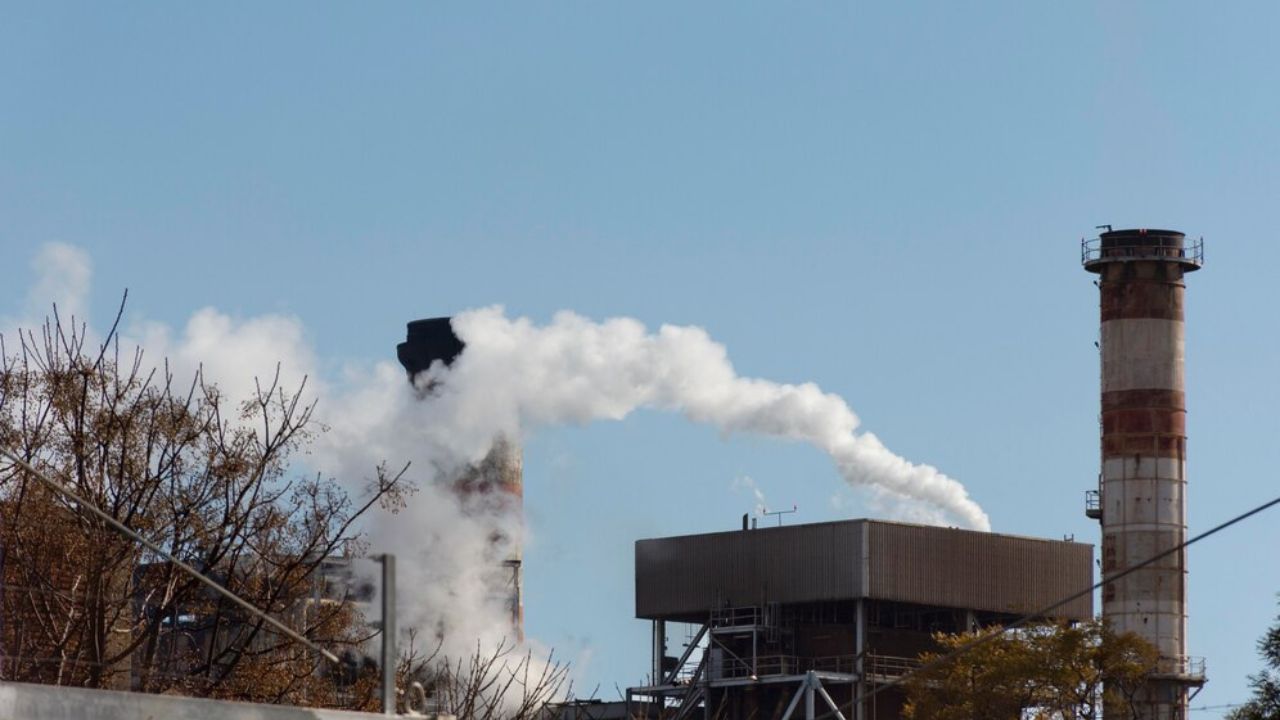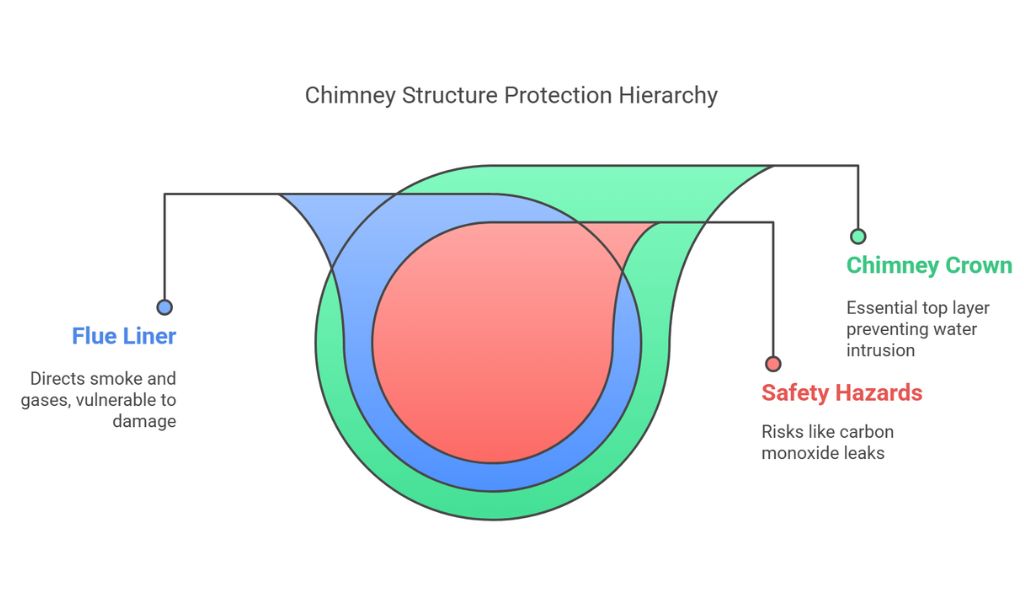The chimney crown may not draw much attention, but it serves one of the most essential roles in protecting the structure of a chimney and, by extension, the home itself. We will explore how a cracked chimney crown, when ignored or underestimated, can become the starting point of widespread damage that reaches far beyond the fireplace. The chimney crown is the topmost surface of the chimney, often made from poured concrete or mortar, and is designed to slope outward to shed water away from the masonry below.
It covers and seals the chimney’s opening while directing rain, snow, and melting ice off its surface to prevent water from seeping inside. When intact and functioning, it preserves the structural integrity of the chimney. However, water starts to work into the masonry system when cracks begin to form—whether from freeze-thaw cycles, poor construction, or aging materials. Even minor hairline fractures can expand over time, allowing moisture to infiltrate, freeze, and exert pressure that widens the gap. This cycle repeats, and with each round, the damage grows.
Ways a cracked chimney crown
1. How Water Penetration Affects Masonry Over Time
Once a chimney crown is compromised, the most immediate concern becomes water infiltration, one of the most destructive forces in any masonry structure. Brick and mortar are porous by nature, and while they are designed to withstand some exposure to moisture, constant saturation weakens them significantly. When rain or snow gets through the cracked crown, it saturates the brick-and-mortar joints. During colder months, that trapped water freezes and expands, stressing the masonry from the inside out. This freeze-thaw cycle repeats as temperatures fluctuate, steadily deteriorating the chimney’s structure. The bricks may start to crack or spill, which is when the face of the brick breaks off due to internal pressure.
Mortar joints begin to crumble, and soon, the overall structure loses its cohesion. What starts as a surface-level issue at the top of the chimney can travel downward, spreading through the flue and even into the roofline or attic. Over time, untreated moisture damage can lead to mold growth, wood rot, and staining on interior walls. Not only does the chimney lose its stability, but it also threatens the structural soundness of nearby parts of the home. The cost to repair this kind of progressive damage is much higher than addressing the original crack. It becomes a case of one neglected flaw leading to multiple interconnected failures. To maintain safety and value, homeowners must understand that water doesn’t stay isolated—it finds its way through the path of least resistance and continues until it is stopped.
2. The Link Between Cracked Crowns and Flue Damage
While the chimney crown is the outermost layer of defense, the chimney flue lies beneath and plays a vital role in safely directing smoke, gases, and heat out of the home. A compromised crown can lead to direct damage to the flue liner if water seeps through the cracks. Most flue liners are made of either clay tiles or stainless steel. Neither material fares well when exposed repeatedly to moisture. Clay liners may begin to crack and shift, creating gaps that allow heat and combustion gases to escape into surrounding building materials. Stainless steel liners, though more corrosion-resistant, can still develop rust if water exposure is prolonged. A damaged flue liner isn’t just a structural problem but also a serious safety hazard.
Gaps or cracks in the liner can allow carbon monoxide, a colorless and odorless gas, to leak into living spaces. In addition, an uneven flue lining disrupts airflow, making the chimney less efficient at venting smoke, which increases the risk of smoke backup or chimney fires. The flue must remain sealed and stable to serve its function, protecting it from water intrusion at the source. Repairing or replacing a flue liner can be costly and labor-intensive, especially when the original problem—a cracked crown—was avoidable. Protecting the flue begins at the top, and ensuring the chimney crown is sealed correctly and maintained is a simple but powerful step in preserving both function and safety.
3. How Cracks Signal Broader Structural Problems
Cracks in the chimney crown often indicate more than surface damage—they can be the visible symptom of deeper issues developing within the chimney structure. For example, if the chimney crown was poorly constructed or made from inferior materials, its early failure might indicate that other parts of the chimney were built similarly. Settlement cracks or shifting crowns may also point to movement in the foundation or improper flashing where the chimney meets the roof. In such cases, water doesn’t only enter through the crown but finds multiple pathways to compromise the system. As water penetrates and freezes, it causes bricks to become loose, leading to instability. Over time, entire chimney sections can begin to lean or collapse. Interior damage like damp ceilings, peeling paint, or mysterious musty odors can often be traced back to compromised masonry stemming from crown issues.
Homeowners may first notice minor signs—perhaps a water stain near the fireplace or bricks flaking off near the top—, but without understanding the source, these are easy to dismiss. In truth, addressing the chimney crown early prevents a domino effect that can eventually necessitate rebuilding the entire structure. Keeping the crown intact is one of the most straightforward forms of prevention against costly repairs and structural decay. If masonry deterioration is already present, professional chimney tuckpointing may be required to restore the mortar joints and stabilize the brickwork. Still, even that is more manageable than replacing entire walls or dealing with interior damage.
Chimney crowns may be small in surface area compared to other house parts. Still, they carry an outsized responsibility in shielding the home from water intrusion and structural decay. When left unaddressed, a single crack in this protective layer opens the door to damage that can affect bricks, mortar, flue liners, interior ceilings, and even the foundation of the chimney itself. Recognizing the warning signs and acting quickly to repair or replace a cracked crown is one of the most effective ways to maintain the longevity and safety of the chimney and the surrounding structure. With seasonal weather changes and constant exposure to the elements, no part of the chimney takes a harsher beating than the crown. Investing time and care in its upkeep pays dividends across the entire home. For homeowners looking to preserve value and avoid structural headaches, a well-maintained crown is the first—and most important—line of defense.








































